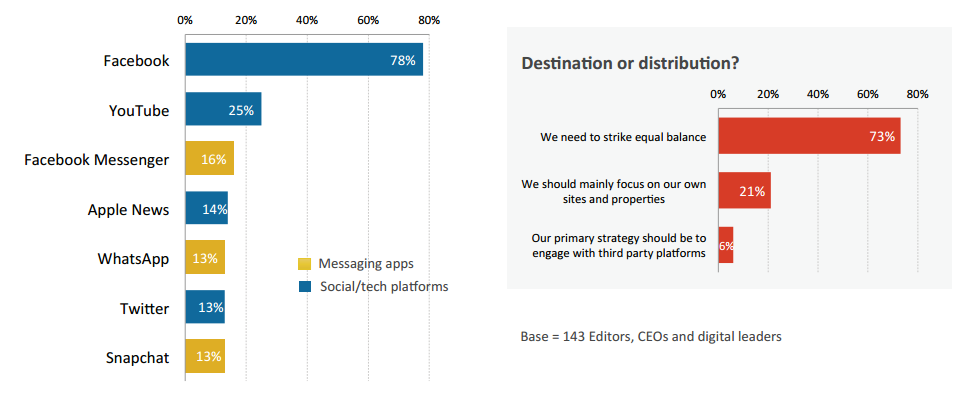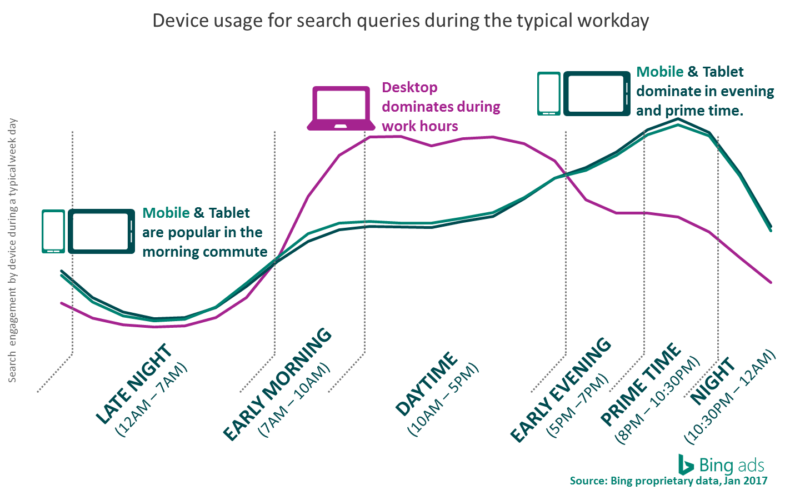This year’s trends in journalism, the potential of news alerts, desktop vs. mobile usage, iPad sales numbers, and more are covered in this installment of TFP’s Media Metrics roundup.
To help you keep up with trends and prepare for changes just around the corner, each month we compile excerpts from some key reports covering issues affecting the publishing and media industries. Here are our top picks.
 What’s the Big Journalism Trend for 2017? Fear (Oh, and Voice News Bots) (Nieman Lab)
What’s the Big Journalism Trend for 2017? Fear (Oh, and Voice News Bots) (Nieman Lab)
- Many of the highlights of Reuters Institute’s annual prediction report center on the rise of social platforms and the quality of information: While 70% of media leaders surveyed said worries about fake news on social networks will “strengthen their position,” 46% are more concerned about the role of platforms compared with last year.
- Another major concern is financial sustainability, with 33% of those in the newspaper business more worried about their company than last year. When it comes to digital ad revenue, it noted, Google and Facebook account for 99% of growth.
- Other trends include voice news bots like Amazon’s Alexa and Google Assistant. Among the apps expected to play an “important” or “very important” role this year are Facebook Messenger (56%), WhatsApp (53%), and Snapchat (49%).
Reuters Study: News Alerts Have Great Potential (WAN-IFRA)
- Reuters Institute data shows news alerts are popular, with 39% of consumers in Taiwan receiving news notifications, followed by 33% in the U.S., 27% in the U.K., and 24% in Germany. However, only half of all app users receive news alerts.
- According to the report, 38% of those who don’t get news alerts have “no interest” in getting them in the future. But 31% of that group said they might be interested if alerts were customized to their interests, and 36% said they would be willing to consider them if they could control the number of alerts they receive. Most respondents said breaking news is the most important type of news alert (66%).
- Three-quarters of users (73%) who do receive news alerts are satisfied with the number of alerts they receive, and 72% said news notifications are “a critical backbone” of journalistic missions.
The Desktop’s Death Has Been Greatly  Exaggerated (Search Engine Land)
Exaggerated (Search Engine Land)
- Although mobile search has officially overtaken desktop, the latter still dominates during the workday and remains the platform of choice for certain research and complex purchasing decisions, according to a Search Engine Land report.
- Citing eMarketer data, it said desktop accounts for 80% of conversions compared with only 20% on mobile.
- While users now spend three hours a day on mobile devices on average, 90% of that time is spent in apps.
Apple iPad Decline Continues with 19 Percent Drop in Holiday Quarter (Apple Insider)
- Apple iPad sales in the holiday quarter fell to 13 million units from more than 16.1 million units in the same period last year.
- iPad revenue for the period was down 22% from about $7 billion to $5.5 billion.
- About 8 million fewer iPad units shipped in the quarter compared with the first quarter of 2015.
Apple Will Surpass 1 Billion Active iPhones by 2019, UBS Estimates (Business Insider)
- Meanwhile, UBS projected there will be 1 billion-plus active iPhones in fiscal year 2019 (October 2018 through September 2019), “something many analysts are focused on to predict iPhone upgrade demand,” a Business Insider report said.
- One analyst firm is predicting a “supercycle” in iPhone replacement demand where “iPhone’s installed base will be nearly 80% larger entering the iPhone 8 cycle than it was entering the strong iPhone 6 cycle.”
- UBS and others, however, have indicated that they expect users will upgrade over time across later models “instead of one big upgrade for one model,” the report said.
Putting a Number to the ‘Bad Ads’ on Google (Media Life)
- Google took down 1.7 billion “bad ads” this past year, double the number it removed in 2015, the company said.
- By comparison, it removed just 220 million bad ads five years ago.
- The search giant also suspended about 1,300 “tabloid cloaker” (fake news) accounts, deleted 17 million ads for illegal gambling, and took down 6,000 accounts for advertising counterfeit products.
One in 10 U.S. Readers Consider Facebook a News Outlet (Recode)
- According to a Pew study of U.S. consumers, almost half couldn’t remember where they got their online news within two hours of reading it.
- One in 10 people named Facebook as the source of news stories they read online.
- The report said 36% still get online news by visiting the website of news outlets, while 35% consume news on social media sites.
- To find news, respondents use a search engine (20%) more often then opening an email from a news organization (15%).
More Than 60 Percent of Snapchat Users Skip Ads on the Platform (Digiday)
- According to a Fluent survey, 69% of American adults overall said they skip Snapchat ads “always” or “often,” and 80% of respondents 18 to 24 years old said the same.
- The poll found 61% don’t follow any news outlets on Discover, 50% don’t follow any sports brands on the channel, and 57% of users don’t follow entertainment brands.
Instagram’s Web Footprint Surpassed Twitter’s in 2016 (Marketing Land)
- Data from website tool provider SimilarTech indicates Instagram’s footprint overtook Twitter’s in 2016, growing 308% versus 36%, respectively.
- In May 2016, the number of websites featuring Instagram posts and widgets shot up 77% month over month, driving the overall 2016 results. The report said that spike may have been related to Instagram’s shift from a reverse-chronological feed to an algorithm-based one that ranks posts based on what users are interested in seeing.
- It also noted the growth of Instagram’s monthly user base from 400 million people in September 2015 to 600 million people in December 2016 also contributed to more sites embedding Instagram posts and widgets on their pages.
Knight Report on Podcasting: Diversity, Infrastructure, Better Analytics Needed (MediaShift)
- According to a Knight Foundation report, most podcast hosts are white and male—and audiences reflect that: 63% of listeners are white, 16% African American, 12% Hispanic, 4% Asian, and 5% “other.”
- Of podcasts created by public media organizations to reflect more diverse audiences, few are in the top 100 podcasts in iTunes.
- However, data shows the percentage of podcasts hosted by women has grown in recent years, from 11% in 2013 to 22% today.
Facebook Now Gets Almost $20 from Each U.S. and Canadian User, Compared to Under $5 at Its IPO (Business Insider)
- In Q4, Facebook reported average ad revenue per user in the U.S. and Canada jumped to $19.81. That compares with $13.70 per user in the last three months of 2015 and just $4.08 at its IPO in 2012.
- On an annual basis, the social platform generated $62.23 per U.S. and Canadian user in 2016 versus $13.58 in 2012.
- Its total worldwide revenue per user climbed to $4.83 in Q4, a $1 increase compared with the same period a year ago. In May 2012, that figure was just $1.21.
36 percent of publishers are wading into VR and AR (Digiday Pulse)
- In a Digiday Publishing Summit poll, 36% of respondents said they are creating virtual and augmented video, indicating publishers are experimenting with VR and AR but it’s far from mainstream.
- The report indicated cost remains a barrier, though some news organizations, such as the Associated Press, are using low-cost equipment like Ricoh cameras and Samsung gear.
- In terms of audience, 1 million consumers used Samsung’s VR headset at least once in the past month, the company reported. In the next 12 months, Samsung projects it will sell between 15 million and 16 million headsets.
Media Metrics is a monthly feature from Technology for Publishing, aimed at keeping you armed with the latest industry data. If you’d like to share something you’ve read, drop us a note. And keep up with the latest industry news coverage by signing up for our This Week in Publishing emails and our Publishing Innovations newsletter.
Posted by: Margot Knorr Mancini


